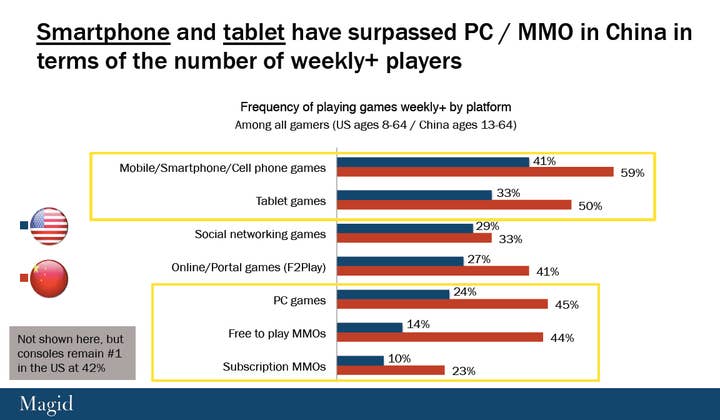Gaming more pervasive in China than US - report
Smartphones, tablets have also eclipsed PC/MMO in terms of gaming frequency in China, according to research from Frank N. Magid Associates
A new report, provided exclusively to GamesIndustry International, reveals some interesting differences between the gaming habits of people in the US and people in China. Perhaps the biggest difference of all is the simple question of whether or not a person plays video or computer games. While in China a whopping 84 percent answered yes, that figure drops to 69 percent for America.
Magid's report shows that the pervasive gaming habit in China has been fueled primarily by increases in tablet and smartphone gaming. 79 percent of people in China play games on a tablet weekly (57 percent on a smartphone).
Because the internet itself is so intricately connected to gaming in China, it's worth noting that that can affect survey results. "The base in the study I sent is Chinese internet users - which skews younger, more urban, more educated than the general Chinese population. The US internet population is much more reflective of the US pop," said Tom Godfrey, Executive Director at Frank N. Magid Associates. "And the fact that over two-thirds of the broad US audience is gaming is a huge figure. Our latest study (Smartphones and Tablets 2013) found that 68 percent of US tablet owners and 66 percent of US smartphone owners play games weekly or more their devices."
The rise of smartphones and tablets has really taken over the gaming culture in China. Mobile gaming and tablet gaming has risen to 59 percent and 50 percent, respectively, in terms of the number of weekly players. That eclipses PC gaming and free-to-play MMOs, which stand at 45 and 44 percent, respectively.

"Smartphones are one of the first truly affordable personal computing devices in China and have really leapfrogged the PC market there. There was certainly a gaming culture beforehand, but it was centered around internet cafes and was somewhat niche. Mobile has expanded access to gaming significantly," noted Godfrey.
Smartphones have become so critical to the Chinese populace that 90 percent said they couldn't live without one. Only 43 percent of Americans said the same about their smartphones.
There's also a fairly large discrepancy when it comes to purchasing habits within games. In China 67 percent of iPad users and 63 percent of Android tablet users say that they buy virtual goods. In the US, those numbers drop to 37 and 33 percent. Similarly, 52 percent of iPhone users and 40 percent of Android smartphone users say that they buy virtual goods. Once again that dips to just 28 and 14 percent for the US.
While that may seem alarming for developers of free-to-play games in the US, Godfrey isn't concerned. The discrepancy is slowly eroding, he believes.
"The pay to download model is virtually non-existent in China and publishers like Tencent and Nexon have had a longer time to develop and optimize their freemium offers. In the last year or so, major US publishers have moved dramatically towards the microtransaction model as well so we'd expect to see the gap narrow significantly going forward," he said.
Notes on methodology
Magid's online study in the US was fielded April 24 - May 8, 2013 and included a nationally representative sample of 2,400 8-64 year olds, matched to the US Census. In China, Magid fielded the same survey from September 8-14, 2013 among a sample of 1,000 13-64 year old Internet users. The sample is weighted to match the demographics of Chinese Internet users (~60 percent under 30).

